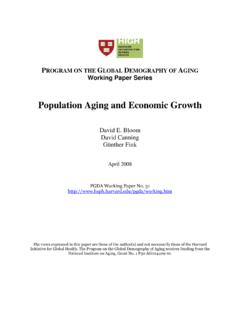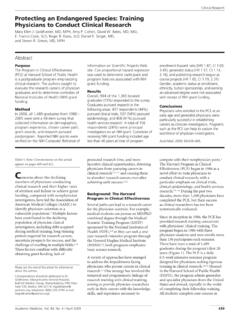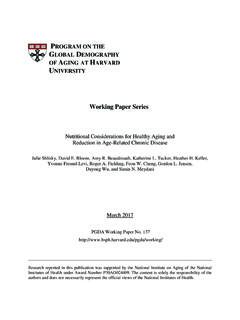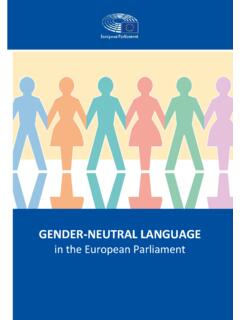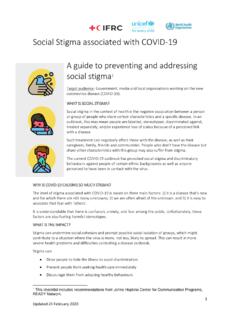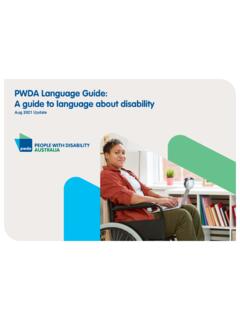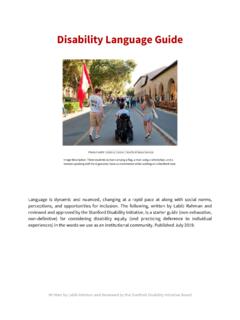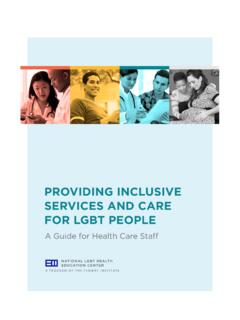Transcription of ORARC Tip Sheet: INCLUSIVE DEMOGRAPHIC DATA …
1 If you share or use this Tip sheet , please credit its content to the Office of Regulatory Affairs and Research Compliance ( ORARC ) v4/20/2020 ORARC Tip sheet : INCLUSIVE DEMOGRAPHIC data COLLECTION Purpose: The purpose of this tip sheet is provide researchers with guidance on how to collect DEMOGRAPHIC data from participants in an INCLUSIVE , representative way. Recommended Practices: 1. In order to uphold the Belmont Report ethical principles of respect for persons (treating humans with respect), beneficence (do no harm), and justice (representative sample), researchers should give careful thought to the options provided to participants when collecting DEMOGRAPHIC data . 2. Researchers must balance the protection of human subjects when including underrepresented populations - namely, minimizing risks to subjects vs. exploitation of vulnerable populations.
2 3. Researchers should assess whether or not this information about participants is needed to accomplish the goals/aims of the study. If not, the researcher should consider not collecting it at all. If this data is needed, gender identity, sexual orientation, race, and ethnicity are four categories where INCLUSIVE options should be provided. See below for suggestions. 4. Regardless of the specific options, consider the following when designing a survey/study: a. Give the participant the option to skip, omit, and/or not respond to any question they do not wish to answer. b. Do not force a response/choice on any DEMOGRAPHIC question. c. Provide the option to select multiple responses, rather than one single choice, on DEMOGRAPHIC questions ( select all that apply vs. select one ). d. All human subjects research is required to include a consent process where participants are reminded participation is voluntary.
3 Suggested DEMOGRAPHIC data Collection Language: 1. Gender Identity DEMOGRAPHIC data Collection Options: Female Male Non-binary/third gender Prefer to self-describe Prefer not to say Transgender Cisgender Agender Genderqueer A gender not listed 2. Sexual Orientation DEMOGRAPHIC data Collection Options: Straight/Heterosexual Gay or Lesbian Bisexual Queer Asexual Prefer to self-describe Prefer not to say 3. Race DEMOGRAPHIC data Collection Options: American Indian or Alaskan Native Asian Black or African American Native Hawaiian or Other Pacific Islander If you share or use this Tip sheet , please credit its content to the Office of Regulatory Affairs and Research Compliance ( ORARC ) v4/20/2020 White Some other race, ethnicity, or origin Prefer to self-describe Prefer not to say 4. Ethnicity DEMOGRAPHIC data Collection Options: Are you of Hispanic, Latino/a/x, or of Spanish origin?
4 (one or more categories may be selected) No, not of Hispanic, Latino/a/x, or Spanish origin Yes, Mexican, Mexican American, Chicano/a/x Yes, Puerto Rican Yes, Cuban Yes, Another Hispanic, Latino/a/x or Spanish origin Some other race, ethnicity, or origin Prefer to self-describe Prefer not to say Training & Resources: Training: o Fenway Health - Learning Modules on Health/Clinical Care for LGBTQ and Gender Non-Conforming Patients o CITI Program Training - Gender and Sexuality Diversity (GSD) in Human Research Module Resources: o FDA Guidance on Collection of Race and Ethnicity data in Clinical Trials o Department Of Health And Human Services Implementation Guidance On data Collection Standards For Race, Ethnicity, Sex, Primary Language, And Disability Status o Office of Management and Budget (OMB); Federal guidance on Standards for Maintaining, Collecting, and Presenting Federal data on Race and Ethnicity o Surveillance (GenIUSS) Group 2014 Survey - Best Practices for Asking Questions to Identify Transgender and Other Gender Minority Respondents on Population-Based Surveys o Human Rights Campaign - Collecting Transgender- INCLUSIVE Gender data in Workplace and Other Surveys o 2011 Report - The Health of Lesbian, Gay, Bisexual, and Transgender People.
5 Building a Foundation for Better Understanding by the Institute of Medicine (US) Committee on Lesbian, Gay, Bisexual, and Transgender Health Issues and Research Gaps and Opportunities o GLAAD Media Reference Guide o How to Write Better DEMOGRAPHIC Survey Questions (With Examples) o Multi-Regional Clinical Trial (MRCT) at Brigham & Women s Hospital and Harvard - Representation of Diverse Populations o National LGBT Health Education Center Publications Glossary of LGBT Terms for Health Care Teams Guidelines and Tips for Collecting Patient data on Sexual Orientation and Gender Identity Affirmative Care for Transgender and Gender Non-Conforming People: Best Practices for Front-line Health Care Staff Learning to Address Implicit Bias Towards LGBTQ Patients: Case Scenarios Collecting data on Sexual Orientation and Gender Identity in Health Centers




